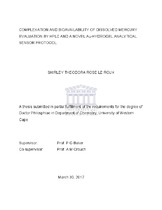| dc.contributor.advisor | Baker, P.G. | |
| dc.contributor.advisor | Crouch, A.M. | |
| dc.contributor.author | Le Roux, Shirley Theodora Rose | |
| dc.date.accessioned | 2018-07-31T12:40:17Z | |
| dc.date.available | 2018-07-31T12:40:17Z | |
| dc.date.issued | 2017 | |
| dc.identifier.uri | http://hdl.handle.net/11394/6133 | |
| dc.description | Philosophiae Doctor - PhD (Chemistry) | |
| dc.description.abstract | Anthropogenic sources as well as natural contributions (e.g. volcanic activity and evaporation
from the oceans) have increased mercury levels in the environment. Mercury deposits mainly in
sediments, and it finally ends up in aquatic systems. Sediments are capable of immobilising
toxic metals but this does not guarantee that the metals are safely removed from aquatic
systems. | |
| dc.language.iso | en | |
| dc.publisher | University of the Western Cape | |
| dc.title | Complexation and Bioavailability of Dissolved Mercury Evaluation by Hplc and a Novel Au-Hydrogel Analytical Sensor Protocol. | |
| dc.rights.holder | University of the Western Cape | |

